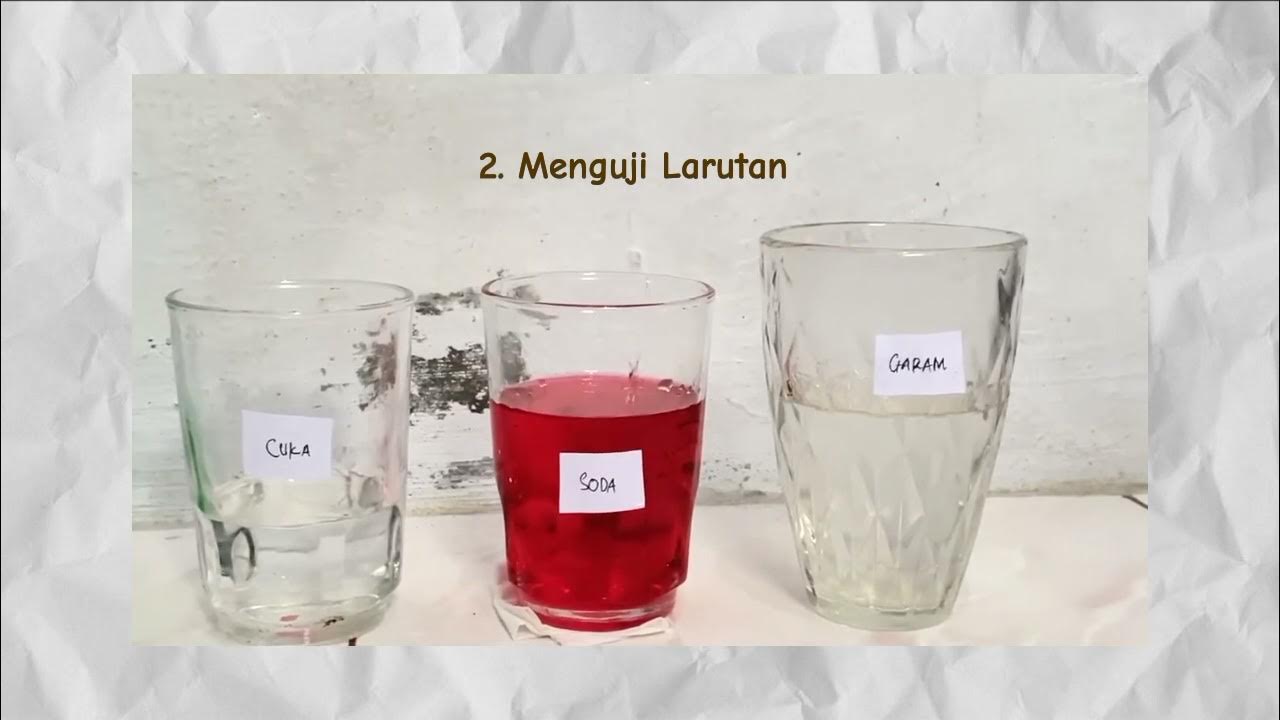Praktikum Uji Daya Hantar Listrik (Larutan Elektrolit dan Non Elektrolit)
Summary
TLDRIn this video, an experiment is conducted to test the conductivity of different solutions. The setup involves connecting a light bulb, crocodile clips, and a battery to test the solutions. First, a sugar solution is tested, which does not light up the bulb. After cleaning the equipment, vinegar and a soda drink are tested, but neither causes the light bulb to shine. Finally, a salt solution is tested, which results in the light bulb glowing brightly. The experiment demonstrates the concept of electrolytes and non-electrolytes.
Takeaways
- 😀 The video demonstrates an experiment to test the conductivity of different solutions.
- 😀 Basic materials required for the experiment include crocodile clip wires, a light bulb, and a battery.
- 😀 The setup starts with connecting the crocodile clips to the battery and the light bulb.
- 😀 The experiment is used to test whether the light bulb lights up, which indicates successful conductivity.
- 😀 The first solution tested is sugar water, where the light bulb does not light up and no bubbles are observed.
- 😀 After testing sugar water, it is necessary to rinse the materials with water and wipe them with a tissue to avoid contamination.
- 😀 The second solution tested is vinegar, which also doesn't light up the bulb, but small bubbles are observed.
- 😀 After testing vinegar, the materials are rinsed again before testing the next solution.
- 😀 The third solution tested is a sweet drink, which also does not light the bulb but produces a few bubbles.
- 😀 The final solution tested is salt water, which causes the light bulb to light up brightly and generates many bubbles.
- 😀 After completing the experiment, the video concludes with a summary about electrolytes and non-electrolytes, comparing the results to the materials being studied.
Q & A
What is the main purpose of the experiment in the video?
-The main purpose of the experiment is to test the electrical conductivity of different solutions to understand their properties as electrolytes or non-electrolytes.
What materials are needed for the experiment?
-The materials required are crocodile clips, wires, a lamp, a battery, and different solutions (sugar solution, vinegar, a drink, and salt water).
How do you set up the experiment?
-First, connect one crocodile clip to the wire, then connect the wire to the battery. The second crocodile clip is attached to the lamp. Afterward, the setup is tested by dipping the wire into various solutions.
What is the first solution tested in the experiment?
-The first solution tested is a sugar solution, and it is observed that no bubbles appear and the lamp does not light up, indicating it is a non-electrolyte.
What happens when the sugar solution is tested?
-When the sugar solution is tested, no bubbles are formed, and the lamp does not light up, indicating that sugar solution does not conduct electricity.
How is the equipment cleaned between tests?
-The equipment is cleaned by rinsing with water and then drying it with a tissue to prevent cross-contamination between the solutions.
What is the second solution tested in the experiment?
-The second solution tested is vinegar. When tested, small bubbles are seen, but the lamp still does not light up, indicating vinegar is not a strong conductor of electricity.
What happens when vinegar is tested?
-When vinegar is tested, small bubbles appear, but the lamp does not light up, indicating that vinegar is also a poor conductor of electricity, though it is weakly acidic.
What is the third solution tested in the experiment?
-The third solution tested is a beverage (which could be a soft drink or similar liquid). Similar to the previous solutions, small bubbles are formed, but the lamp does not light up, indicating it does not conduct electricity.
What is the final solution tested, and what happens when it is tested?
-The final solution tested is saltwater. When tested, many bubbles are formed, and the lamp lights up brightly, indicating that saltwater is an electrolyte that conducts electricity well.
What is the conclusion of the experiment?
-The conclusion is that substances like sugar, vinegar, and certain drinks are non-electrolytes and do not conduct electricity, while saltwater, being an electrolyte, conducts electricity effectively.
Outlines

Этот раздел доступен только подписчикам платных тарифов. Пожалуйста, перейдите на платный тариф для доступа.
Перейти на платный тарифMindmap

Этот раздел доступен только подписчикам платных тарифов. Пожалуйста, перейдите на платный тариф для доступа.
Перейти на платный тарифKeywords

Этот раздел доступен только подписчикам платных тарифов. Пожалуйста, перейдите на платный тариф для доступа.
Перейти на платный тарифHighlights

Этот раздел доступен только подписчикам платных тарифов. Пожалуйста, перейдите на платный тариф для доступа.
Перейти на платный тарифTranscripts

Этот раздел доступен только подписчикам платных тарифов. Пожалуйста, перейдите на платный тариф для доступа.
Перейти на платный тарифПосмотреть больше похожих видео

video praktikum sederhana " Larutan Elektrolit dan Non elektrolit"

Video Pembelajaran Materi Konduktivitas

Percobaan Uji Daya Hantar Listrik Larutan

Colourimetry (testing for glucose in urine) - Biology A-level Required Practical

Strong, Weak, and Non-Electrolytes

Science 7 - Components of a solution ( solute and solvent)
5.0 / 5 (0 votes)
